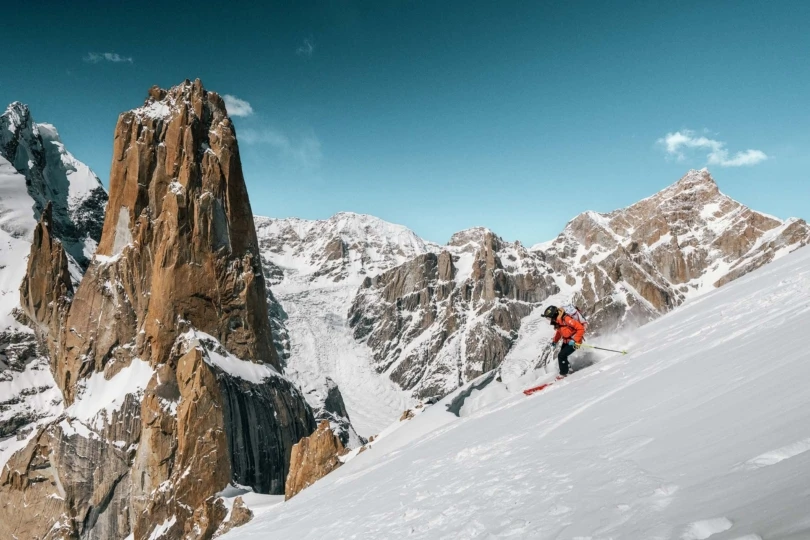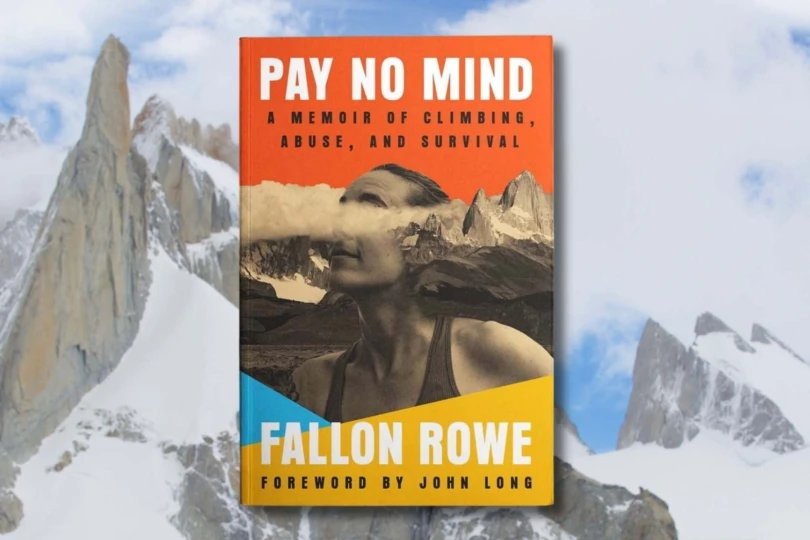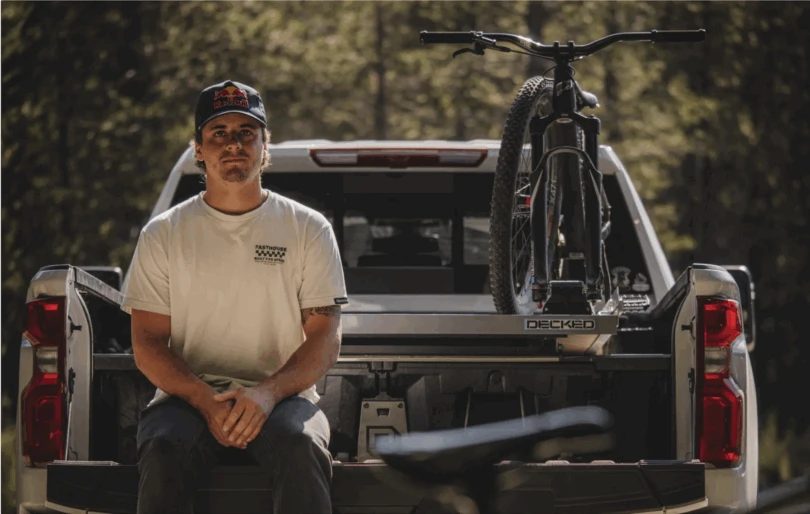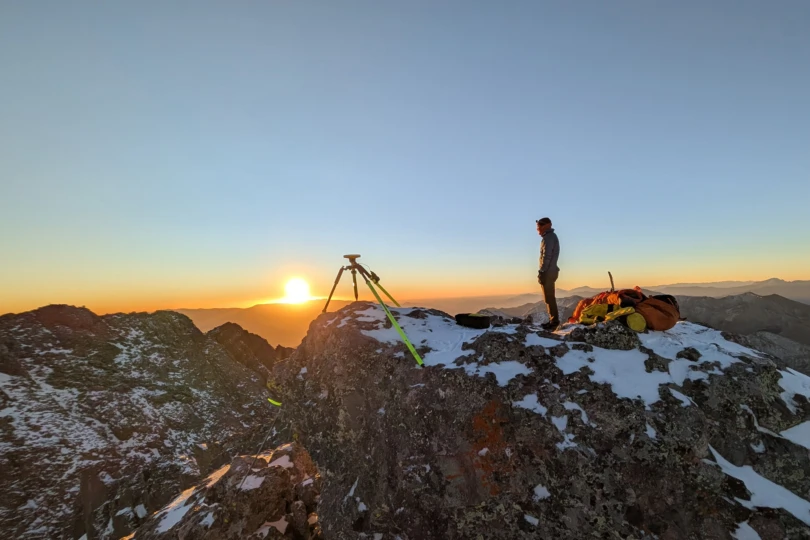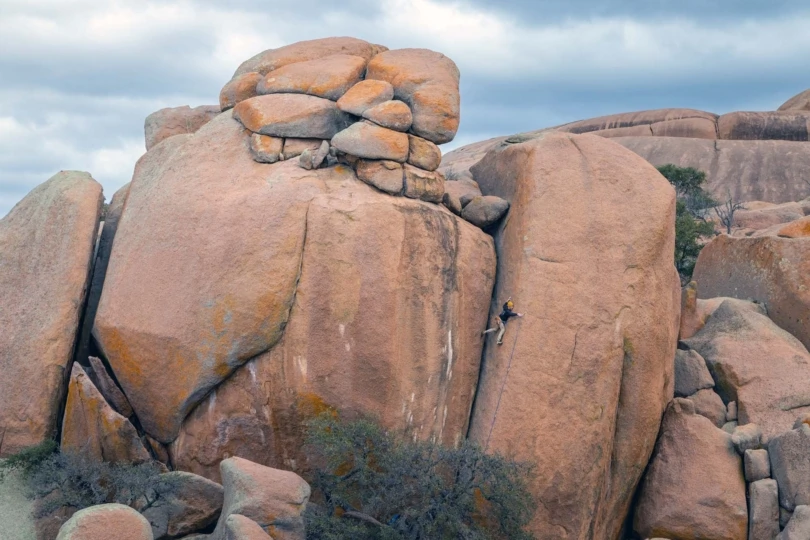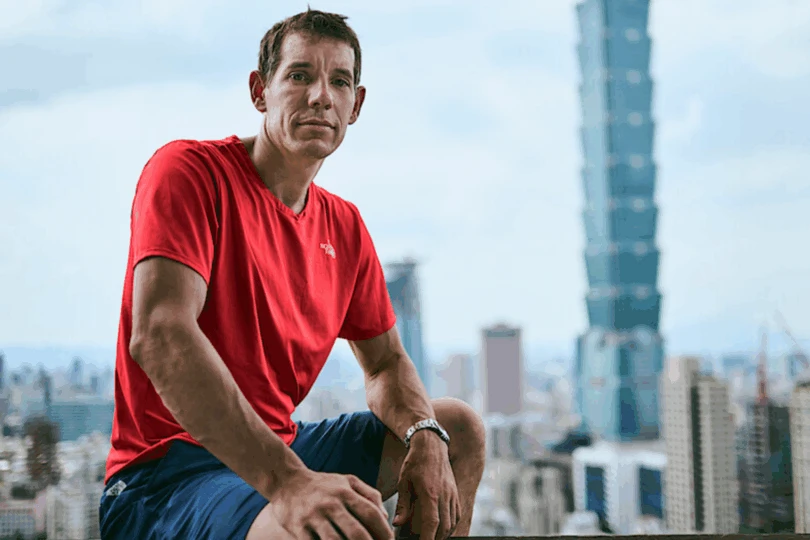The exponential growth of social media has altered the fundamentals of outdoor endeavors. Rock climbing is not immune. From boasting about “sends” to blasting the whereabouts of your favorite crag, social media has eroded the foundations of climbing.
There is no denying that social media has significantly impacted how climbers share information about noteworthy ascents and the sport.
But one app in particular — the flashy, highly visual Instagram (IG) — has radically reshaped the landscape, not always in a good way. Like most climbers these days, I have an Instagram account. I scroll through my feed about once a day to see what’s up in the climbing world.
But at age 50, I’m far from an influencer or a super-user. I mostly post MoonBoarding videos, cat selfies, and random esoterica from my life. Still, I like following the pro climbers to see what they’re up to at the cutting edge. There are positives to Instagram for climbing; it can help democratize the sport and provide endless inspiration.
Many of us old-school climbers are used to emptier, quieter cliffs. But I’ve seen the damage Instagram can cause. The app, with its emphasis on vivid imagery, instant gratification, and likes, has the potential to blow up climbing areas when they go viral.
And everyone wants to snap that perfect IG-ready shot of that one climb. Instagram has the potential to put outcome over process, leading us all to drown in “spray.” And there are other adverse effects. What to do?
Enter Instagram
I first noticed this shift 3 or 4 years ago, in 2018. On a cold October day with the long-range forecast looking bleak on the Front Range of Colorado and way too many gym sessions looming, my friend Ryan and I snuck out to Eldorado Canyon for a few hours of bouldering.
In the canyon, the creek was low, its crystalline waters oozing around water-slicked cobbles, yellow and brown leaves collecting in the eddies.
We warmed up on Eastern Priest, a V4 highball. I’d been curious about the problem for years, plus Eastern Priest had also been showing up in my Instagram feed — a lot. Its tan and purple-banded rock that showcases the white-chalked holds, creekside setting, and ease of scrambling up the opposite riverbank to snap photos make it the classic IG-ready bloc. I’d also be lying if I said that it wasn’t IG that had piqued my curiosity.
Nobody else was there, so Ryan and I did laps and snapped a few photos. I’d later post an image on IG with the facetious caption, “Found this really chalky and fun Bo Prob in Eldo today. I doubt any pix of it have ever been on social media. Anyone know what it’s called?”
At the time, I didn’t have a large following; I got 56 likes and six comments — pretty meager numbers. It was doubtful my post would draw more attention to Eastern Priest.
View this post on Instagram
View this post on Instagram
The Beginnings of Doing It for the ‘Gram
However, the scene up-canyon at Resonated (V9) was a different story. As we approached the boulder, there was a hum of voices, almost a cacophony.
“Uh-oh,” I said.
“Shit,” Ryan said.
We dropped into the creekbed to find a multi-hued carpet of crash pads and a dozen boulderers standing around in puffies and hoodies, queuing up. We knew two of the folks there, so we said our greetings, added our crash pads, and got in line.
Like Eastern Priest, Resonated is also very “Gram-able.” It rises above South Boulder Creek, and if you step back to take a photo, you can frame fall foliage and the river’s clear waters. The crux is a bearhug span that makes for good climbing porn. And pro climber Paul Robinson first climbed Resonated, giving it that extra cachet.
It’s a sought-after, four-star problem for good reasons. While it’s reasonable to expect to see other climbers there (crowds on weekends are typical on the Front Range), this was the next level. Not necessarily for the number of suitors but how they chose to “climb.”
View this post on Instagram
Many of the boulderers seemed to have no intention of actually sending. They’d climb up into “the move,” have their friends take photos, and then immediately jump off. Then they started chimping through the images on their phones to see which were the best. Later, after the big pack left, another smaller group showed up, and I tried to offer beta, gleaned after an hour of trying the problem.
“Naw, we’re good, man,” said one of the climbers. “There’s no need.” He and his crew bumbled up into “the move,” shooting photos of each other, and then jumping off.
“Let’s go to Whole Foods and get some burritos,” one suggested. “Great idea,” said another. “I’m starving.”
Maybe I’m just old and out of touch, but I always thought that if you went out climbing, you went out climbing. To try your hardest and, on a good day, get up something.
But these folks weren’t there to climb. They were just there for the Gram. As I watched them pack up their pads, all I could think was, “What the hell happened to our sport?”
The Upsides of Instagram for Climbing
Before we get into the predictable “crusty old-guy” rant, let’s look at some of the positives of Instagram. The first is democratization. Instagram has allowed all climbers to be storytellers.
I worked in climbing media for years, pre-internet and even during web 1.0. Magazines were the gatekeepers for news, which homogenized the storytelling. If you weren’t a Big Name Sponsored Climber at a Big Name Area being photographed by a Big Name Photographer who had contacts at the magazines, it almost didn’t matter how compelling your story was. You weren’t getting any print.
As blogs and MySpace appeared, the balance began to shift. Elite and every-person climbers alike could recount their tales in an unmediated voice to a receptive audience. Around 2006, Facebook put even more powerful storytelling/marketing/audience-building tools into climbers’ hands. Then Instagram appeared in 2010, emphasizing photography, the most visceral media touchpoint.
These days, Instagram has become the primary source for climbing news. You can get the stories and images from the horse’s mouth without delay and the clumsy interpolation of media professionals like myself.
Climbers as Storytellers
Take Seb Bouin (@sebbouin), who has 67.9K followers, exceeding the print subscriber base of most (if not all) climbing magazines. When he finally redpointed his multiyear Verdon Gorge project DNA (5.15d) in April, where did most of us hear about it first? Probably the ‘Gram, or a “news story” that was a cut-and-paste job of Bouin’s post.
As Bouin wrote in his post, which featured an eye-catching image of him in try-hard mode, drop-kneed against a micro-tufa, the climb took a heroic 150-plus days and 250 attempts. Bouin, as so many climbers do these days, led off with the route name and the ubiquitous green check box.
View this post on Instagram
Instagram as a Climbing Sounding Board
Instagram has also led to the healthy discourse around the racist/misogynistic route names that our community engaged in the summer of 2020 after the death of George Floyd. Yes, some of these discussions on IG and other social media platforms turned into flame-war shitshows, but good ideas were brought to the forefront. And ultimately, Instagram led to crags like the Slavery Wall at Ten Sleep, Wyoming, being renamed more thoughtfully and inclusively (it’s now the Downpour Wall).
Kathy Karlo (@inheadlights) is an itinerant climber, writer, and the podcaster behind “For the Love of Climbing.” “Social media has allowed every person, regardless of climbing background or status, to speak their truths and address issues that inevitably play an important role in equitable accessibility in climbing culture,” she said.
This shift can be a net positive in a sport that was traditionally open only to America’s white middle/upper class because of structural and economic barriers. This is especially true as climbing demographics broaden with the rise of climbing gyms in urban centers.
Meanwhile, Instagram can be a community morale booster in a sport where we’re often scared and/or failing. “It’s cathartic to share my trials and tribulations and my successes, especially because climbing is one of the most important things in my life. I like to know what people are up to — different routes and areas,” said Neely Quinn (@neelyquinn), a nutritionist and the founder of the coaching outfit Training Beta.
“It feels good to share about things and get support from my community. The ‘Nice work!’ or ‘What a cool shot!'”
Crowdsourcing Information on Instagram
Instagram is also great for sharing information about new routes or crags. Professional climber Jonathan Siegrist (@jonathansiegrist) said, “Countless trips have been inspired by random photos online, which in turn yield months of new experience and dozens of new friends.”
Siegrist hunts through his feed for new or obscure cliffs to visit, such as God’s Crag in southwestern Colorado. He added a host of new climbs up to 5.14 in summer 2020, making a film about it with the photographer and filmmaker Nate Liles (@orographic_visual) and sharing that on YouTube and via social media.
“The social medias have really given birth to a new class of industry professionals and certainly created more financial opportunities for established pro climbers like myself,” said Siegrist.
View this post on Instagram
Ah, the Imagery!
As a tool for outdoor photographers, Instagram is nearly without peer. “The platform allows me to share with my fellow climbers and adventurers things that inspire me — cool moves or routes, epic backdrops, and idyllic scenery,” said Levi Harrell (@ofallnationsmedia).
Harrell is an outdoor photographer who adds that while he doesn’t make money directly from social media, his imagery there has led to tens of thousands of dollars in work.
“It also lets me draw inspiration and ideas from some of the best photographers in our industry.” Harrell also uses IG to location-scout — things like the rock quality, sun pattern, and ideal time to climb/photograph a route.
Tara Kerzhner (@tarakerzhner) is the photographer and filmmaker behind iconic films like “Slaydies.” She uses the platform for marketing. Brands have noticed her IG imagery and cross-referenced it with her site, which led to contracted work.
Finally, there’s IG’s entertainment value, its panoptical view of everything everywhere all at once. My favorite climbing posters are the wildly creative ones, like Kate Kelleghan (@katekelleghan), a Colorado climber and designer by trade.
Her posts blend core, fly-on-the-wall climbing action, like a vertigo-inducing reel looking 2,000 feet straight down from Thank God Ledge on Half Dome. She also posts goofy how-tos like “What to bring big wall climbing,” in which her friend flings items out of a massive haul bag.
“I love the idea of a bunch of random strangers with common interests giving their two cents on climbing/other things and enjoying a laugh at the strange and wonderful mundanities of lives,” said Kelleghan.
Not that these posts come easily. Some weeks, Kelleghan will spend 6 hours editing videos or IG stories. She matches music to action or splices together multiple clips from a long weekend to create a cohesive storyline.
View this post on Instagram
The Negatives of Instagram on Climbing
Instagram-Induced FOMO
For me — and this points directly to my insecurity — Instagram creates a horrible Fear of Missing Out (FOMO). Looking at IG too much makes me depressed.
I understand that in a feed populated by the world’s best climbers and young, strong, local superstars, I’m going to see tick after tick — all those green checkboxes. But on an emotional level, it’s different. As much as I can maintain some psyche and throw out a like or two, after a few minutes of scrolling, I get weary of all these sends.
Even if the images are alluring, it’s like drinking from a firehose. And then I start to think, “What have I ticked lately, and does it measure up?” (The answers: “Not much,” and “No.”)
Of course, comparison is the thief of joy. And by comparing myself — an aging never-was, to all climbers everywhere all at once, I will only cultivate eternal dissatisfaction. Not to mention the uncut jealousy I feel seeing climbers in exotic locations like deep-water soloing in Mallorca. In the meantime, I’m stuck in my basement working to feed my ingrate children, with maybe a few hours in the evening to climb local choss.
As Peter Beal (@peterbeal), a longtime climber and commentator on the sport (mountainsandwater.com), put it, “The green check is just one more way of turning an experience into a thing, which is what social media was designed to do. Self-comparison, FOMO, and envy; are all features, not bugs in the system. The best thing to do? Ignore them, just like any bouldering video that starts with a sideways run-and-jump!”
Quinn said, “I used to go on IG and immediately feel terrible about myself because I was following climbers, old friends, family and maybe health influencers, dietitians and nutritionists. Or even political stuff. And I realized that it made me feel really bad.” She changed her feed to be more of a dopamine boost and less of a serotonin killer.
Now she goes on IG to laugh, scrolling through a curated list of “cat memes and dog memes and weird, funny TikTok stuff and art and dance and mom stuff and dad jokes.” Quinn has kept some climbing stuff on there, but not much.
View this post on Instagram
My friend and climbing partner Brandon Fields (@moss_delver) has also had a tortured relationship with the platform. Like many of us, IG appealed to him as a digital scrapbook, a handy way to look back at climbs, trips, and highlight moments. “I assumed I would be able to resist the pull of ‘farming likes,'” he said. “But I was wrong.”
After he posted each new climb (he’s an active first ascensionist), he opened Instagram over and over to check if his latest picture had any new reactions, to the detriment of his mental health.
“Even being aware of it and actively wanting to avoid this type of behavior wasn’t enough,” he said. Like all social media apps, the app is addictive; its algorithms keep us scrolling. Fields now posts less frequently — in fact, his last post was in November 2021.
Training Porn
Think about your feed and all the “stupid climber tricks” and “challenges.” One-armed hangs while eating a banana, pullups with another climber hanging off, front levers on the 6mm Beastmaker edge.
And — during the pandemic lockdown — people hand-traversing their kitchen countertops. How does all this training porn make you feel? Inspired, fired up, ready to hit the gym, or sad and deflated because you’ll never be that strong?
It’s certainly exciting to see how beastly the top climbers can be. As an avid MoonBoarder, I follow Hoseok Lee (hoseok_lee93). He does stupid-hard footless span moves on the board with the tension of a coiled spring, then cranks one-arm pullups on the finishing hold. He’s so much stronger than I’ll ever be and climbs in such a different fashion that I can’t be jealous. Lee is thrilling to watch, like a Cirque du Soleil acrobat.
View this post on Instagram
But what happens when we try to emulate these feats without proper training because we’re so Insta-inspired? Usually, it’s Insta-injury. At Training Beta, Quinn tries to avoid the training-porn trap on their social feed and in their podcast.
“Say I’m interviewing Kyra Condie, and she’s saying that she does three days of training then one day off, and doing one-arms and one-armed hangs and campusing and all that,” said Quinn. “My goal is to let my audience know, ‘This is for Kyra; Kyra is highly trained. She has been doing this for many, many years. She knows her limits. This is not something you should be doing.'”
Plus, these feats are only one part of the climbing experience. However, for newer climbers, said Quinn, it can be hard to step back from training overstoke, especially when there’s so much glamour around training.
“We’ll have a 10c climber who’s training six days a week but is not getting better because they’re training six days a week,” said Quinn. Instead, she urges clients to train smarter and more appropriately for where they’re at. For example, working footwork drills and building an endurance base their first year instead of training for one-arms.
Body Toxic Culture
Another related problem is body dysmorphia and a body-toxic culture. They are often cultivated through deliberate choices with clothing, camera angles, and the app’s many filters.
“It’s hard to ignore all the perfectly edited bodies of women who don’t really look like that, and while climbing has moved toward a more inclusive and body-positive tone, there is certainly still a strange sexualized nature to a lot of climbing content,” said Kelleghan. “I hate that.”
Someone even duplicated her IG account, which features a few images of her in a sports bra, and linked it to an OnlyFans page whose bio read, “Follow along on my naughty adventures.”
“Puke,” said Kelleghan, who added that she’s also received creepy DMs (“I love you, you perfect girl”; “I often dream about getting groceries with you”). Some people respond a bit too attentively to every last story and post — “simps” in internet jargon.
Blowing Up Your Climbing Spot
High above Boulder, Colorado, on the eastern flanks of Green Mountain, is a flatiron called Hillbilly Rock. For years, climbers seldom visited. They came mainly for the 5.0-to-5.4 multi-pitch routes on its east face, though there were a couple of 5.12 sport routes on the overhanging west face. In 2018 and 2019, friends and I added two more sport climbs to the west face—a 5.12d and a 5.13a—but they received little attention.
Then, in March 2020, on the last day before Boulder County went into its first COVID lockdown, we established a new 5.13+ next to them. I shared the climbs on Mountain Project but never posted anything on Instagram, which is pretty typical.
The COVID + Instagram Effect
Once the rock gyms closed that March, desperate climbers flooded the hills. They were looking for off-the-beaten-path venues in the pandemic’s early days of rigorous social distancing. Hillbilly Rock was one such place. It also has a notch uphill of the west face that lets you take good photos, overlooking the narrow crease of Skunk Canyon and formations farther south. The wall is “IG ready.”
Soon images of the climbs proliferated on the ‘Gram, and the crag got even more crowded and remained busy. So busy that local land managers had to set up trail days to consolidate the approach up a steep, eroding hillside.
Of course, this is all anecdotal, but at least at Hillbilly, I had directly seen the IG Effect. Especially when “influencers” with significant follower numbers visited and then posted images and videos.
As Beal put it, “IG hype happens every week around Boulder, so you get used to it.”
Well, sort of. For me, as a first ascensionist who often sees the cliffs in their nascent form, it can feel tragic to see them become busy overnight.
The Purity Ring Example
Colorado climber Tyler Dziedzina started the account @frontrangecrackbouldering in February 2021. The account documents the granite crack boulder problems that he and his friends climb in the South Platte region west of Denver and elsewhere.
“In the long run, it’s introduced me to many awesome people and helped build a little community … or a cult of crack,” he joked. For months, his was an obscure account documenting a niche pursuit. His first post from February 7, 2021, of the VO fissure Fine Cheese Club Initiation had only 30 likes.
On December 22, 2021, he posted two images of Purity Ring (V9), an alluring off-fingers splitter up an overhanging boulder near the Cathedral Spires. The problem took Dziedzina 20-plus days and 200-plus attempts, a personal goal he worked on during unemployment. The Purity Ring post got 615 likes.
“People were suddenly very interested in crack bouldering, and that boulder saw many strong climbers giving it a go — including Isabelle Faus, Chad Greedy, and Vasya Vorotnikov, to name a few,” said Dziedzina. He also posted the climb on Mountain Project.
View this post on Instagram
Living only minutes from the bloc, Dziedzina came out one day to find 15 people under it. Purity Ring had gone viral, and photos of the problem were all over everyone’s IG feed. Overwhelmed by the crowds, he tried to lure climbers off to try other projects and spread the impact.
Soon people were tick-marking the crack, stashing pads, and leaving trash. At one point, someone even installed a tarp over the boulder to keep the snow off.
“I didn’t hesitate to put that behavior on blast on my Instagram and had private group discussions about what could be done better,” said Dziedzina. On March 1, the problem shut down as part of a raptor-nesting closure, giving the boulder and its environs time to rejuvenate until July 31, when it will open again.
Posing (And Rescue and Death)
Instagram also seems part of a larger syndrome; the dumbing down of climbing by social media, including YouTube, Facebook, and online route databases like Mountain Project. Climbing is inherently dangerous. Or, more accurately, falling is, and if you don’t come to a quick accord with the relentless effects of gravity on an unrestrained human body, you will get hurt — or worse.
In an era in which more than 700 commercial climbing gyms in North America are churning out hordes of new climbers, this remains more important than ever. Especially when newer climbers are turning to social media for “mentorship” because there are no longer enough experienced climbers to go around.
Think I’m Exaggerating?
Check out this recent Mountain Project forum post: “Howdy!! Anyone want to show me the freeway in Boulder?” In it, the poster, who last climbed in a gym a decade ago, asks for someone to guide him free solo up the Freeway route on the Second Flatiron. “You won’t be responsible for me, just someone to follow :),” he wrote optimistically.
Freeway is “only” 5.0, but in a way, it’s not. It’s easy to wander off the most accessible line, quickly finding yourself on a bald, exposed 5.4 to 5.7 slab.
I took my two boys up it in May. In the brief minutes that it took me to scramble up the first pitch and begin bringing them up, I had to help a free soloist who’d seized up in a crack above me. I had to help her get back down to my stance and rappel off the route, before she — encouraged by her “friend” — kept going, with who knows what result.
Drew Hildner, the public information officer for the Rocky Mountain Rescue Group (RMRG), stated they had to pluck three stuck soloists/scramblers on 3 consecutive days off the Flatirons in late June. One needed rescue when he became “fatigued” at the spot where the woman had frozen above me on the Second Flatiron.
Of course, none of this is statistically attributable to social media or the ‘Gram. But neophyte or casual climbers are being told by the likes of Alex Honnold that serious, sustained, unroped fifth-class climbing is “scrambling.” And when a #yolofreesolo attitude, especially on “easy” routes like the east faces of the Flatirons, predominates, we have a problem.
There is a certain naiveté here, fueled by arrogance and inexperience and the echo chamber of social media, where videos and images of ropeless climbers on the formations proliferate.
A Growing Lack of Awareness
“Writing anecdotally, I think there probably is a growing lack of awareness and possibly disregard for the risks of free soloing,” wrote Rick Hatfield, a ranger in Boulder’s Open Space and Mountain Parks (OSMP). He held the job for 24 years before taking early retirement this June.
Hatfield stated in an email, “There is the obvious fall risk, but over and above that, some new soloists attracted to the activity might lack basic outdoor skills like route finding, ability to self-rescue, ability (or desire) to assist others in need, and in the quest for faster and lighter ascents lack water and essential clothing for changing weather.” All of which can contribute to potential rescues.
Dan Hammond, a longtime climber and an OSMP ranger, stated that the gym-to-crag pipeline is an undeniable factor in the explosion of unprepared soloists. (Boulder is also a unique situation. The various formations of the Flatirons provide more moderate/low-angle rock climbs than you’ll find in some entire states, all on the edge of a metropolitan area.)
On the day my boys and I did Freeway, we must have seen 100 soloists go by — some much less “dialed” than others, and many soloing in tennis shoes in huge, perilous conga lines.
Twenty years ago, when I used to solo regularly in the Flatirons, you’d never see that many people going ropeless. If you did, they were experienced climbing alone or with a friend.
Phillip Yates, a spokesperson for OSMP, confirmed that OSMP rangers have anecdotally seen an increase in free soloing, though he added, “Whether that anecdotal increase is related to social media is very difficult for us to say.”
Per data that Hildner sent me from the RMRG, there has been an overall rising trend in Boulder County over the past 12 years for rescues of “scramblers” or “stuck persons” (the search terms they used to comb their database of an average 200 rescues/year). However, the causes of this trend remain unclear.

“Now, people are climbing hard in the gym and thinking that translates when they go outdoors, and how-to-videos from sources of varying credibility exist everywhere on social media,” said Hammond.
“They might look at the low grade of the Second Flatiron and think, ‘I can climb 5.10 in the gym. This will be easy.’ Some tend to only account for the physical nature of climbing and forget to account for the psychological component, only to realize 200 feet up that the consequences of an alleged ‘easy scramble’ just became very real.”
It’s All #yolofreesolo Until …
It’s all #yolofreesolo until your foot slips and you ragdoll to an untimely demise. Or, as Hildner put it, “A common thing we hear from those who are unfortunate to get hurt from or witness a scrambling accident is how surprised they are about the violence of the fall and the severity of the injuries. Gravity still applies on lower-angle climbs; it just takes its time, as you fall, to beat you up more before you ground out.”
This brings us back to the IG posedown I described on Resonated at the opening of this story. Instagram has helped create an alternate reality seemingly divorced from real-world consequences. With good camera work, filters, and some hype, we can turn even a mediocre rock climb or achievement into a viral “must-climb classic.”
In this alternate reality, we can get on climbs above our pay grade and feed them to our followers. All for a few seconds of dopamine as the likes, comments, and “good job, bros” pile on. But is this what we want from our climbing — this sham reality?
“Instagram has encouraged the death of authenticity and the rise of poser culture in climbing. When I was a grungy ’90s skater kid, the lowest form of existence was to be a poser. You had to earn respect, and value was not self-proclaimed — it was bestowed by your peers,” lamented Siegrist.
But of course, Instagram lets us hack this. Are we who we say we are on the platform as long as our followers buy it? And this vibe is changing the sport.
“Gone are the days where the social media-less climbers outnumber the masses posting their #climbersofinstagram shot. Some want the free swag or pro code for sharing their ass shot with a climbing brand. Others want the #glory and the small endorphin rush that comes with a few hundred likes,” said Harrell. “Either way, they are in it for something other than what people sought from climbing before Instagram.”




